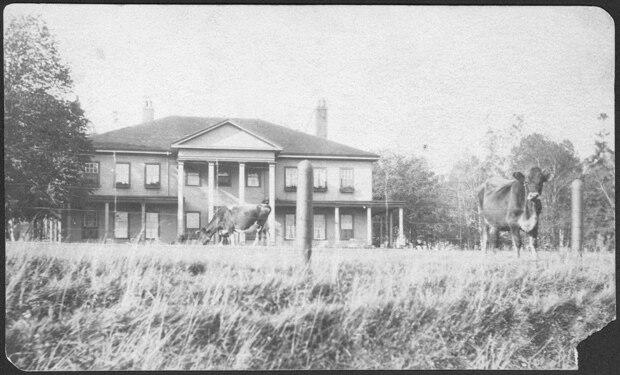Flu season and home remedies in P.E.I.'s bygone days
Reginald (Dutch) Thompson's column The Bygone Days brings you the voices of Island seniors, many of whom are now long-departed. These tales of the way things used to be offer a fascinating glimpse into the past. Every second weekend CBC P.E.I. will bring you one of Dutch's columns.
Sometimes in the bygone days 100 years ago or more on P.E.I., the cure for the flu sounded worse than the affliction —remedies like turpentine and cow manure were not uncommon.
Back then you didn't go running off to the drugstore looking for quick chemical fixes for coughs, aching joints and runny noses.
Instead, mothers and grandmothers had the salvation needed from the flu right at home, and every family had variations of certain home remedies.
One very popular cure for the flu, colds and pneumonia were turpentine and kerosene: sometimes applied externally and sometimes internally.

Turpentine and goose grease
A few drops of turpentine or kerosene on a teaspoon of sugar was one home remedy.
"The main medicine then in them days was either a dose of [epsom] salts, or if you got wounded somewhere or other it was always kerosene oil, and wrap it up," said Milton Buell from Abney in eastern P.E.I., near Murray River.
"If you had a bad cough too, it'd be kerosene oil and sugar." His mother would feed him five or six drops of kerosene on a half-teaspoon of sugar.

"It didn't taste too bad," Buell said.
Turpentine and kerosene were often mixed with various things to use externally, too: onions, garlic, and another favourite home remedy ingredient — goose grease.
"They would rub your chest with goose grease and a little bit of turpentine, I believe, at that time," said Kay Wood from Victoria. "That was guaranteed to take the hair off your chest!"
Grease saved while butchering a goose would be saved and mixed with camphor oil, oil of wintergreen or cod liver oil.
A good stiff drink
Even doctors on P.E.I. practised some home remedies of their own.
Dr. MacLean in Souris made his own remedy for the Spanish flu of 1918-1919 — his own special tonic. Robbie Robertson's family of 14 children took it every morning and it seemed to work, Robertson said.
Down in Murray River, Dr. Brehaut chewed tobacco to ward off the flu. Many people thought if you chewed tobacco and drank rum you wouldn't catch the flu.

And sometimes a good stiff drink helped cure the flu. Although liquor was tightly controlled on P.E.I. for much of the last century, certain retail vendors were allowed sell to any person presenting a prescription 24 ounces of wine or spirits or 12 quarts of ale "not oftener than once a day," according to the history of liquor on the P.E.I. government's website. However, this quantity could be doubled if the person lived more than 10 miles from the vendor. These prescriptions came to be known as "scripts," and were written by doctors. "If you couldn't get scripts, at that time of course moonshine was available," recalled Wood. "I can remember one fella, he thought he was taking the flu — and that was the deadly flu, the very early flu — he went somewhere and he got a bottle of moonshine and he drank it, and he flopped on the floor. And the next day he was fine!"
Take a salt herring and split it and put one on each foot, tie it on each foot, to take the fever down. — Amy Bryanton
An interesting sidebar: people were not able to freely buy liquor on P.E.I. until 1967, when the law was changed to finally abolish permits that had been required to buy it.
Some people claimed a snort of moonshine and chew of twist tobacco also did the trick of warding off the flu.
Another piece of advice was "don't stand in a doorway or you'll catch the flu." That old adage was often repeated — people believed doorways were where germs are most prevalent.
Mustard plaster on the chest
If there was congestion in the chest with the cold or flu, you may have been administered a mustard plaster, which was a popular home remedy until fairly recently.

They were a mixture of one-third flour and two-thirds dry mustard, mixed with hot water into a thick paste then applied to the chest or back and covered with a cloth. Sometimes goose grease or onions were added too.
Dorothy Palmer trained as a nurse in the 1920s.
"But nursing was nothing like it is today," she explained. She was instructed to administer mustard plasters every four hours to patients who had pneumonia, along with lots of fresh air from an open window no matter the weather.
"And you just slapped them on for 20 minutes then left them, then in four hours you had to slap them on again," Palmer said. "That was the only treatment we had. Sometimes they got better and sometimes they didn't."
And for a fever?
One old Maritime cure for a fever was an application of warm cow manure, fresh from the cow. Others went with salt herring.

Amy Bryanton from Spring Valley lived to be 104. She told Dutch about one cold she had at the age of four or five.
"We had neighbours just lived across the field from us," she said. "Jake Duggan and the wife, Ellen. Somewhere or other they had heard that I was sick with the cold. So Mrs. Duggan told mum to take a salt herring and split it and put one on each foot, tie it on each foot, to take the fever down."
That's exactly what her mother did, but then they had to carry Bryanton anywhere she wanted to go, because she had herring tied to her feet.
Salt herring had almost magical healing powers as a home remedy — people wrapped it around their necks to cure a bad cough, as well as salt pork.
As smelly as that sounds, it was an alternative to one even smellier cure. In Britain, people were given horse dung water: a mixture of horse manure, ginger, molasses and other spices, Dutch reports.

More P.E.I. news


